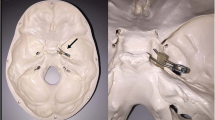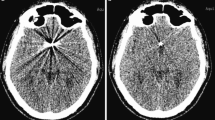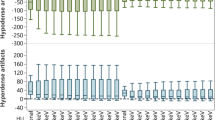Abstract
Purpose
To evaluate the ability of dual-energy CT angiography (DECTA) in metal artifact reduction in patients with treated intracranial aneurysms by comparing DECTA-based virtual monoenergetic extrapolations (VMEs) and mixed images (MI).
Methods
Thirty-five patients underwent prospectively a dual-source DECTA (Somatom Force, Siemens Medical Solutions, Forchheim, Germany) after aneurysm repair. A total number of 40 aneurysms (23 treated by coil embolization and 17 treated by surgical clipping) were analyzed. Mixed images (equivalent to a conventional single-energy CT angiography) were compared to VMEs at 75, 95, and 115 keV. Artifact severity was assessed quantitatively by measuring the mean attenuation value and standard deviation within regions of interest placed in the most hypodense coil or clip artifact area. Artifact severity score and contrast vessel score were also assessed qualitatively by two independent blinded readers.
Results
In those aneurysms treated by surgical clipping, quantitative and qualitative analyses showed significant reduction of artifacts on VMEs compared to MI with the best compromise being obtained at 95 keV in order to keep an optimal vessel contrast in the adjacent vessel. In those aneurysms treated by coil embolization, there was no significant reduction of artifacts both on quantitative and qualitative analyses.
Conclusion
Dual-source DECTA was helpful in order to reduce clip artifacts on VMEs with the optimal adjacent vessel visualization obtained at 95 keV, whereas this technique was not helpful in aneurysms treated by coiling.







Similar content being viewed by others
References
Li H, Pan R, Wang H, Rong X, Yin Z, Milgrom DP, Shi X, Tang Y, Peng Y (2013) Clipping versus coiling of ruptured intracranial aneuryms, a systematic review and meta-analysis. Stroke 44:29–37
Johnston SC, Dowd CF, Higashida RT, Lawton MT, Duckwiler GR, Gress DR (2008) Predictors of rehemorrhage after treatment of ruptured intracranial aneurysms, the CARAT study. Stroke 39:120–125
Kaufmann TJ, Huston IIIJ, Mandrekar JN, Schleck CD, Thielen KR, Kallmes DF (2007) Complications of diagnostic cerebral angiography: evaluation of 19 826 consecutive patients. Radiology 243:812–819
Dehdashti AR, Binaghi S, Uske A, Regli L (2006) Comparison of multislice computerized tomography angiography and digital subtraction angiography in the postoperative evaluation of patients with clipped aneurysms. J Neurosurg 104:395–403
Wallace RC, Karis JP, Partovi S, Fiorella D (2007) Noninvasive imaging of treated cerebral aneurysms, part I: MR angiographic follow-up of coiled aneurysms. AJNR Am J Neuroradiol 28:1001–1008
Wallace RC, Karis JP, Partovi S, Fiorella D (2007) Noninvasive imaging of treated cerebral aneurysms, part II: CT angiographic follow-up of surgically clipped aneurysms. AJNR Am J Neuroradiol 28:1207–1212
Gölitz P, Struffert T, Ganslandt O, Saake M, Lücking H, Rösch J, Knossalla F, Doerfler A (2012) Optimized angiographic computed tomography with intravenous contrast injection: an alternative to conventional angiography in the follow-up of clipped aneurysms? J Neurosurg 117:29–36
Schaafsma JD, Koffijberg H, Buskens E, Velthuis BK, van der Graaf Y, Rinkel GJE (2010) Cost-effectiveness of magnetic resonance angiography versus intra-arterial digital subtraction angiography to follow-up patients with coiled intra-cranial aneurysms. Stroke 41:1736–1742
Marin D, Boll DT, Mileto A, Nelson RC (2014) State of the art: dual-energy CT of the abdomen. Radiology 271:327–342
Patino M, Prochwoski A, Agrawal MD, Simeone FJ, Gupta R, Hahn PF, Sahani DV (2016) Material separation using dual-energy CT: current and emerging applications. Radiographics 36:1087–1105
Johnson TRC (2012) Dual-energy CT: general principles. AJR 199:S3–S8
McCollough CH, Leng S, Yu L, Fletcher JG (2015) Dual- and multi-energy CT: principles, technical approaches, and clinical applications. Radiology 276:637–653
Bamberg F, Dierks A, Nikolaou K, Reiser MF, Becker CR, Johnson TRC (2011) Metal artifact reduction by dual energy computed tomography using monoenergetic extrapolation. Eur Radiol 21:1424–1429
Fahrendorf DM, Goericke SM, Oezkan M, Breyer T, Hussain S, Sandalcioglu EI, Sure U, Forsting M, Gizewski ER (2011) The value of dual-energy CTA for control of surgically clipped aneurysms. Eur Radiol 21:2193–2201
Shinohara Y, Sakamoto M, Iwata N, Kishimoto J, Kuya K, Fujii S, Kaminou T, Watanabe T, Ogawa T (2014) Usefulness of monochromatic imaging with metal artifact reduction software for computed tomography angiography after intracranial aneurysm coil embolization. Acta Radiol 55:1015–1023
Dolati P, Eichberg D, Wong JH, Goyal M (2015) The utility of dual-energy computed tomographic angiography for the evaluation of brain aneurysms after surgical clipping: a prospective study. World Neurosurg 84:1362–1371
Dunet V, Bernasconi M, Hajdu SD, Meuli RA, Daniel RT, Zerlauth JB (2017) Impact of metal artifact reduction software on image quality of gemstone spectral imaging dual-energy cerebral CT angiography after intracranial aneurysm clipping. Neuroradiology 59:845–852
Jia Y, Zhang J, Fan J, Sun Y, Li D, Xiao X (2015) Gemstone spectral imaging reduced artefacts from metal coils or clips after treatment of cerebral aneurysms: a retrospective study of 35 patients. Br J Radiol 88:20150222
Yu L, Primak AN, Liu X, McCollough CH (2009) Image quality optimization and evaluation of linearly mixed images in dual-source, dual-energy-CT. Med Phys 36:1019–1024
Yu L, Leng S, McCollough CH (2012) Dual-energy CT based monochromatic imaging. AJR Am J Roentgenol 199:S9–S15
Yu L, Christner JA, Leng S, Wang J, Fletcher JG, McCollough CH (2011) Virtual monochromatic imaging in dual-source dual-energy CT: radiation dose and image quality. Med Phys 38:6371–6379
Landis J, Koch G (1977) The measurement of observer agreement for categorical data. Biometrics 33:159–174
Winklhofer S, Hinzpeter R, Stocker D, Baltsavias G, Michels L, Burkhardt JK, Regli L, Valavanis A, Alkadhi H (2018) Combining monoenergetic extrapolations from dual-energy CT with iterative reconstructions: reduction of coil and clip artifacts from intracranial aneurysm therapy. Neuroradiology 60:281–291
Postma AA, Das M, Stadler AA, Wildberger JE (2015) Dual-energy CT: what the neuroradiologist should know. Curr Radiol Rep 3:16
Postma AA, Hofman PAM, Stadler AAR, van Oostenbrugge RJ, Tijssen MPM, Wildberger JE (2012) Dual-energy CT of the brain and intracranial vessels. AJR Am J Roentgenol 199:S26–S33
Henzler T, Fink C, Schoenberg SO, Schoepf UJ (2012) Dual-energy CT: radiation dose aspects. AJR Am J Roentgenol 199:S16–S25
Bakker NA, Westerlaan HE, Metzemaekers JDM, van Dijk MC, Eshghi OS, Mooij JJA, Groen RJM (2010) Feasibility of magnetic resonance angiography (MRA) follow-up as the primary imaging modality after coiling of intracranial aneurysms. Acta Radiol 51:226–232
Author information
Authors and Affiliations
Corresponding author
Ethics declarations
Funding
No funding was received for this study.
Conflict of interest
The authors declare that they have no conflict of interest.
Ethical approval
All procedures performed in the studies involving human participants were in accordance with the ethical standards of the institutional and/or national research committee and with the 1964 Helsinki Declaration and its later amendments or comparable ethical standards.
Informed consent
Informed consent was obtained from all individual participants included in the study.
Rights and permissions
About this article
Cite this article
Mocanu, I., Van Wettere, M., Absil, J. et al. Value of dual-energy CT angiography in patients with treated intracranial aneurysms. Neuroradiology 60, 1287–1295 (2018). https://doi.org/10.1007/s00234-018-2090-5
Received:
Accepted:
Published:
Issue Date:
DOI: https://doi.org/10.1007/s00234-018-2090-5




